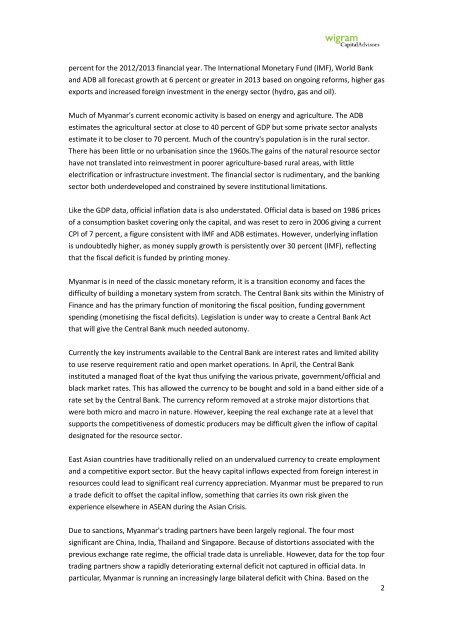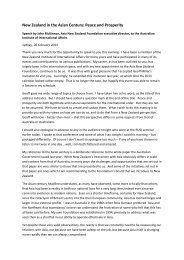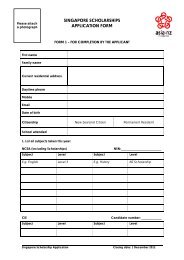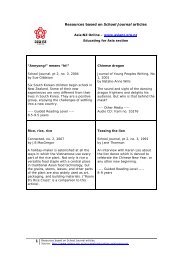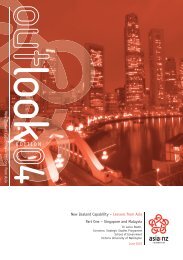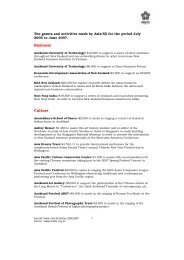1 Myanmar - looking to realise its full potential By Sajini Jesudason ...
1 Myanmar - looking to realise its full potential By Sajini Jesudason ...
1 Myanmar - looking to realise its full potential By Sajini Jesudason ...
You also want an ePaper? Increase the reach of your titles
YUMPU automatically turns print PDFs into web optimized ePapers that Google loves.
percent for the 2012/2013 financial year. The International Monetary Fund (IMF), World Bank<br />
and ADB all forecast growth at 6 percent or greater in 2013 based on ongoing reforms, higher gas<br />
exports and increased foreign investment in the energy sec<strong>to</strong>r (hydro, gas and oil).<br />
Much of <strong>Myanmar</strong>'s current economic activity is based on energy and agriculture. The ADB<br />
estimates the agricultural sec<strong>to</strong>r at close <strong>to</strong> 40 percent of GDP but some private sec<strong>to</strong>r analysts<br />
estimate it <strong>to</strong> be closer <strong>to</strong> 70 percent. Much of the country's population is in the rural sec<strong>to</strong>r.<br />
There has been little or no urbanisation since the 1960s.The gains of the natural resource sec<strong>to</strong>r<br />
have not translated in<strong>to</strong> reinvestment in poorer agriculture-based rural areas, with little<br />
electrification or infrastructure investment. The financial sec<strong>to</strong>r is rudimentary, and the banking<br />
sec<strong>to</strong>r both underdeveloped and constrained by severe institutional limitations.<br />
Like the GDP data, official inflation data is also understated. Official data is based on 1986 prices<br />
of a consumption basket covering only the capital, and was reset <strong>to</strong> zero in 2006 giving a current<br />
CPI of 7 percent, a figure consistent with IMF and ADB estimates. However, underlying inflation<br />
is undoubtedly higher, as money supply growth is persistently over 30 percent (IMF), reflecting<br />
that the fiscal deficit is funded by printing money.<br />
<strong>Myanmar</strong> is in need of the classic monetary reform, it is a transition economy and faces the<br />
difficulty of building a monetary system from scratch. The Central Bank s<strong>its</strong> within the Ministry of<br />
Finance and has the primary function of moni<strong>to</strong>ring the fiscal position, funding government<br />
spending (monetising the fiscal defic<strong>its</strong>). Legislation is under way <strong>to</strong> create a Central Bank Act<br />
that will give the Central Bank much needed au<strong>to</strong>nomy.<br />
Currently the key instruments available <strong>to</strong> the Central Bank are interest rates and limited ability<br />
<strong>to</strong> use reserve requirement ratio and open market operations. In April, the Central Bank<br />
instituted a managed float of the kyat thus unifying the various private, government/official and<br />
black market rates. This has allowed the currency <strong>to</strong> be bought and sold in a band either side of a<br />
rate set by the Central Bank. The currency reform removed at a stroke major dis<strong>to</strong>rtions that<br />
were both micro and macro in nature. However, keeping the real exchange rate at a level that<br />
supports the competitiveness of domestic producers may be difficult given the inflow of capital<br />
designated for the resource sec<strong>to</strong>r.<br />
East Asian countries have traditionally relied on an undervalued currency <strong>to</strong> create employment<br />
and a competitive export sec<strong>to</strong>r. But the heavy capital inflows expected from foreign interest in<br />
resources could lead <strong>to</strong> significant real currency appreciation. <strong>Myanmar</strong> must be prepared <strong>to</strong> run<br />
a trade deficit <strong>to</strong> offset the capital inflow, something that carries <strong>its</strong> own risk given the<br />
experience elsewhere in ASEAN during the Asian Crisis.<br />
Due <strong>to</strong> sanctions, <strong>Myanmar</strong>'s trading partners have been largely regional. The four most<br />
significant are China, India, Thailand and Singapore. Because of dis<strong>to</strong>rtions associated with the<br />
previous exchange rate regime, the official trade data is unreliable. However, data for the <strong>to</strong>p four<br />
trading partners show a rapidly deteriorating external deficit not captured in official data. In<br />
particular, <strong>Myanmar</strong> is running an increasingly large bilateral deficit with China. Based on the<br />
2


